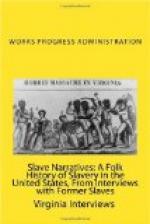“When dey give us our freedom us went right on over to Marse Billie Battle’s place and stayed dar wid Daddy ’bout a year; den Daddy come wid us back to Marse Henry’s, and dar us stayed ’til Old Marster died. Long as he lived atter de war, he wukked most of his help on sheers, and seed dat us was tuk keer of jus’ lak he had done when us all b’longed to him. Us never went to school much ’cause Mammy said white folks didn’t lak for Niggers to have no larnin’, but atter de war was done over our Old Mist’ess let colored chillun have some lessons in a little cabin what was built in de back yard for de white chillun to go to school in.
“Atter dey buried our Old Marster, us moved down to Hancock County and farmed dar, ’cause dat was all us knowed how to do. Us got together and raised money to buy ground enough for a churchyard and a graveyard for colored folks. Dat graveyard filled up so fast dat dey had to buy more land several times. Us holped ’em build de fust colored church in Hancock County.
“School for colored chillun was held den in our church house. Our teacher was a white man, Mr. Tom Andrews, and he was a mighty good teacher, but Lordy, how strick he was! Dese here chillun don’t know nothin’ ‘bout school. Us went early in de mornin’, tuk our dinner in a bucket, and never left ’til four o’clock, and sometimes dat was ’most nigh sundown. All day us studied dat blue back speller, and dat white teacher of ours sho’ tuk de skin offen our backs if us didn’t mind him. Dere warn’t no fussin’ and fightin’ and foolin’ ’round on de way home, ’cause dat white teacher ’lowed he had control of us ’til us got to our Mammies’ doors and if us didn’t git for home in a hurry, it was jus’ too bad for us when he tuk it out on us next day wid dat long hick’ry switch.
“Things is sho’ diffunt now. Folks ain’t good now as dey was den, but dere is gwine to be a change. I may not be here to see it, but it’s a-comin’ ’cause de Good Lord is done ’sied (prophesied) it, and it’s got to be. God’s sayin’ is comin’ to pass jus’ as sho’ as us is livin’ and settin’ in de shade of dis here tree.




